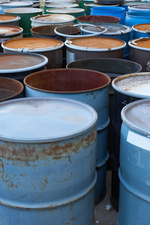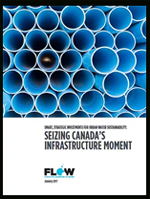We await the announcements for Phase 2 of the federal Infrastructure Plan and how the "Green Infrastructure" funds will be targeted. We will share all information with our members as soon as we know anything and will be working to ensure you are informed on how to access these funds. The same is true for the Community Capacity Building funds and programs to be provided through the Federation of Canadian Municipalities (FCM). Visit https://www.naylornetwork.com/cww-nwl/articles/index-v2.asp?aid=421938&issueID=47529 to view the full article online.
|
Visit https://www.naylornetwork.com/cww-nwl/articles/index-v2.asp?aid=421942&issueID=47529 to view the full article online.
|

In 2016, under the Canadian Safety and Security Program (CSSP), the CWWA began a partnership with the MacEachen Institute for Public Policy and Governance, Dalhousie University, to assess risk and resiliency practices in the water sector. By the end of this year, we will issue a report that details our research findings, and includes a risk profile for the sector and makes recommendations on how to improve the resiliency of the sector.
In the coming weeks, we will invite representatives from selected water utilities and regulators to participate in one-on-one interviews to discuss risk and resilience challenges and opportunities for the sector. If your organization is invited to participate in a one-on-one interview, we strongly encourage you to accept. In the Spring, and following the completion of the one-on-one interviews, we will launch a national survey, open to all CWWA members. We encourage CWWA members to take part in the survey once it is released, to ensure that our research accurately represents the sector as a whole. For more information about the research, please do not hesitate to contact Adrian Toth at atoth@cwwa.ca or (613) 747-0524 ext.5
|
Visit https://www.naylornetwork.com/cww-nwl/articles/index-v2.asp?aid=421741&issueID=47529 to view the full article online.
|
Visit https://www.naylornetwork.com/cww-nwl/articles/index-v2.asp?aid=421902&issueID=47529 to view the full article online.
|
Visit https://www.naylornetwork.com/cww-nwl/articles/index-v2.asp?aid=421487&issueID=47529 to view the full article online.
|
Visit https://www.naylornetwork.com/cww-nwl/articles/index-v2.asp?aid=421595&issueID=47529 to view the full article online.
|
Visit https://www.naylornetwork.com/cww-nwl/articles/index-v2.asp?aid=421604&issueID=47529 to view the full article online.
|
Chloral hydrate is formed as a disinfection by product in chlorinated drinking. It is also an active ingredient in prescription drugs used as sedatives and hypnotics, a medicinal ingredient in natural health products licensed as homeopathic medicines, and an intermediate for industrial metal plating. The screening assessment concluded that it is not a threat to human or environmental health, and the government will be taking no action to regulate it. Visit http://www.gazette.gc.ca/rp-pr/p1/2016/2016-12-17/pdf/g1-15051.pdf to view the full article online.
|
coastal regions. Visit https://www.naylornetwork.com/cww-nwl/articles/index-v2.asp?aid=421609&issueID=47529 to view the full article online.
|
Visit https://www.naylornetwork.com/cww-nwl/articles/index-v2.asp?aid=421488&issueID=47529 to view the full article online.
|
Visit https://www.naylornetwork.com/cww-nwl/articles/index-v2.asp?aid=421491&issueID=47529 to view the full article online.
|
The price tag to address the backlog of repairs and upgrades to municipal water infrastructure in Canada is estimated at $88.5 billion. This report and accompanying policy brief propose a package of recommendations to align water infrastructure investments and regulatory regimes around a vision of sustainability, resilience and innovation. By doing so, we believe that the Government of Canada’s infrastructure plan can play a key role in addressing the backlog of repairs to urban water systems, advance efforts to build sustainable and climate resilient communities, and help Canadian clean water innovators strengthen their position in the $500 billion global water technology and services market. Visit https://media.wix.com/ugd/c3d5ce_bab16811a71b4403a9e594922c852e32.pdf to view the full article online.
|
Engineers, managers and planners rely on Intensity/Duration/Frequency (IDF) statistics to design roadways, culverts, and other drainage structures that can accommodate heavy rainfall and mitigate its impact on habitats, properties and infrastructure. "Providing enhanced access to the most current IDF data through this new Extreme Precipitation website," notes Rick Fleetwood, Manager of ECCC’s Atlantic Climate Services, "makes it easier and more efficient to use this information for engineering designs." Visit https://www.naylornetwork.com/cww-nwl/articles/index-v2.asp?aid=421513&issueID=47529 to view the full article online.
|
Visit https://www.naylornetwork.com/cww-nwl/articles/index-v2.asp?aid=421613&issueID=47529 to view the full article online.
|
Visit https://www.naylornetwork.com/cww-nwl/articles/index-v2.asp?aid=421615&issueID=47529 to view the full article online.
|
Visit https://www.naylornetwork.com/cww-nwl/articles/index-v2.asp?aid=421616&issueID=47529 to view the full article online.
|
Visit https://www.naylornetwork.com/cww-nwl/articles/index-v2.asp?aid=421621&issueID=47529 to view the full article online.
|
Filoform’s mission is to assist you in planning for this opportunity now and to provide you with the best solutions, applications and products to protect your investment in the future. This future includes: - The development of highly efficient and smart energy grids with which the end user has a relationship - both as a buyer and seller of energy. - The creation of decentralized energy production systems to meet local demand for electric mobility. - The utilization of new, safer and sustainable energy sources like wind and solar power. - Changing the way in which we work by planning and developing high data capacity fibre optic networks and different types of mobile communications networks. Visit http://www.filoform.co.uk/ to view the full article online.
|
Visit http://www.bio-pro.ca/ to view the full article online.
|
|
Treatment Plant Operator Magazine
Four workers resigned from a wastewater treatment plant in Apopka, Florida, saying they had concerns about their health and safety. Visit http://www.tpomag.com/online_exclusives/2017/01/news_briefs_workers_resign_from_florida_plant_citing_health_concerns?utm_source=StreamSend&utm_medium=email&utm_content=newsletter&utm_campaign=170116 to view the full article online. |
|
Water Online Magazine
The water industry needs no convincing that it plays a critical role in shaping how communities develop. Water that a plentiful, accessibly and available at a usable quality is at the core of stable public health as well as the production of goods and services which build economies that form the social and cultural fabrics of a society. Water, is therefore, the resource of life. Visit http://www.wateronline.com/doc/integrating-innovative-technology-into-the-public-water-sector-a-need-for-equilibrium-0001 to view the full article online. |
|
Toronto Star
Carrying waste water, sewage and everything in between, more than 11,000 kilometres of sewers lie beneath Toronto’s surface, a snaking network that shuttles millions of litres of liquids to treatment plants, storage tanks or straight out to Lake Ontario every day. Here’s a look at the system essential to keeping the city sanitary and (mostly) dry, but rarely seen by the millions it services. Visit https://www.thestar.com/news/gta/2016/12/29/how-torontos-sewage-system-keeps-us-safe-from-fatbergs-to-preventing-floods.html to view the full article online. |






















